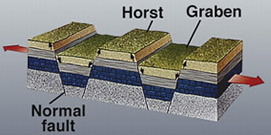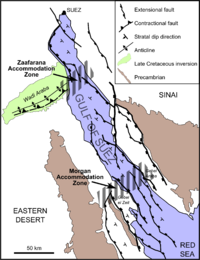Rift



In geology, a rift or chasm is a place where the Earth's crust and lithosphere are being pulled apart[1] and is an example of extensional tectonics.[2]
Typical rift features are a central linear downfaulted segment, called a graben, with parallel normal faulting and rift-flank uplifts on either side forming a rift valley, where the rift remains above sea level. The axis of the rift area commonly contains volcanic rocks, and active volcanism is a part of many, but not all active rift systems.
Major rifts occur along the central axis of mid-ocean ridges, where new oceanic crust and lithosphere is created along a divergent boundary between two tectonic plates.
Failed rifts are where continental rifting began, but then failed to continue to the point of break-up. Typically the transition from rifting to spreading develops at a triple junction where three converging rifts meet over a hotspot. Two of these evolve to the point of seafloor spreading, while the third ultimately fails, becoming an aulacogen.
Examples
- The East African Rift
- The Red Sea Rift
- The Baikal Rift Zone, the bottom of Lake Baikal is the deepest continental rift on the earth.
- The Gulf of Suez Rift
- Lake Timiskaming in Temiskaming Shores, Ontario
- Throughout the Basin and Range Province in North America
- The Rio Grande Rift in the southwestern US
- The rift zone that contains the Gulf of Corinth in Greece
- The Reelfoot Rift, an ancient buried failed rift underlying the New Madrid Seismic Zone in the Mississippi embayment
- The Rhine Rift, in south western Germany, known as the Upper Rhine valley, part of the European Cenozoic Rift System
- The Taupo Volcanic Zone in the north east North Island of New Zealand
- The Oslo Graben in Norway
- The Ottawa-Bonnechere Graben in Ontario and Quebec
- The Northern Cordilleran Volcanic Province in British Columbia, Yukon and Alaska
- The West Antarctic Rift in Antarctica
- The Midcontinent Rift System, a late Precambrian rift in central North America
- The Fundy Basin, a Triassic rift basin in southeastern Canada
- The Narmada Rift valley in peninsular India
See also
References
- ^ Decompressional Melting During Extension of Continental Lithosphere, Jolante van Wijk, MantlePlumes.org
- ^ Plate Tectonics: Lecture 2, Geology Department at University of Leicester
